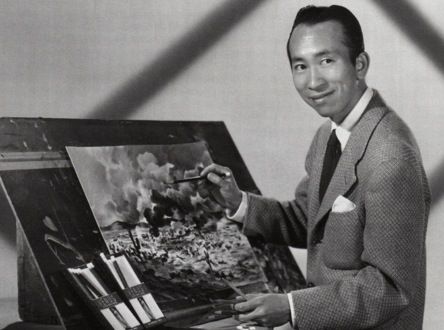Next month, The Walt Disney Family Museum celebrates Walt Disney’s brilliant and timeless 1942 animated feature, Bambi. In this column, we revisit the observations of legendary Disney animators Frank Thomas and Ollie Johnston from their 1990 book, Walt Disney’s Bambi: The Story and the Film, in which they discuss the work of Tyrus Wong.
Many of the backgrounds we were seeing…were very detailed, almost to the point of looking like photographs, and we were having a serious problem with the unbroken expanse of flat color on the animated adult deer against such paintings. The sketches of the deer made for the story reels were far more than outlines and even had suggestions of shadows falling across the bodies. They were like book illustrations, with bits of shading to give the illusion of solidity, define the shapes, and help display the expressions. How could it be done in animation? We could not use shading on our drawings—everything had to be done in line backed up by a single coat of paint. And how could a background with all the leaves and twigs and details of the forest be balanced against such a large, unrelieved area?
 The solution came out of the innovative work of one special artist—Tyrus Wong. His paintings, styling sketches, watercolors, and pastels would give a whole new appearance to the picture, distinct from any we had previously given or would ever give any film.
The solution came out of the innovative work of one special artist—Tyrus Wong. His paintings, styling sketches, watercolors, and pastels would give a whole new appearance to the picture, distinct from any we had previously given or would ever give any film.
Ty had come to California from China at the age of nine. When he was hired at Disney, studio policy had every newcomer start as a lowly in-betweener, executing the often-tedious drawings that filled out the action between the animator’s key drawings. In Ty’s case, it was not a profitable decision. He not only hated the work, but commented that his eyes were beginning to feel like a couple of tennis balls as he flipped the drawings of Mickey and stared at the light in his drawing board. When he heard that experimental work was being done on Bambi, he worked several nights to gather together samples of what he could do. He had read Felix Salten’s book and “thought the story was very, very nice—the feeling—you can almost smell the pine.” He took his sketches to the art director, Tom Codrick. Like those working for him, Tom had been painting realistically. But when he saw these soft-edged, oriental paintings of a mystical forest, he realized instantly that this was just what was needed to make Bambi a different, artistic picture.
In contrast to the paintings that showed every detail of tiny flowers, broken branches, and fallen logs, Ty had a different approach and certainly one that had never been seen in an animated film before. He explained, “Too much detail! I tried to keep the thing very, very simple and create the atmosphere, the feeling of the forest.” His grasses were a shadowy refuge with just a few streaks of the actual blades; his thickets were soft suggestions of deep woods and patches of light that brought out the rich detail in the trunk of a tree or a log. Groups of delicate trees were shown in silhouette against the mists of early morning rising from the meadow. Every time of day and each mood of the forest was portrayed in a breathtaking manner. An ethereal quality was there. Best of all, Walt was enthusiastic. “I like that indefinite effect in the background—it’s effective. I like it better than a bunch of junk behind them.”
When asked about his style, Ty said, “Halfway between the West and the East—but I can’t help that, I’m born with it.” He set the color schemes along with the appearance of the forest in painting after painting, hundreds of them, depicting Bambi’s world in an unforgettable way. Here at last was the beauty of Salten’s writing, created not in a script or with character development, but in paintings that captured the poetic feeling that had eluded us for so long.
Excerpted from the book Walt Disney's Bambi: The Story and the Film by Frank Thomas and Ollie Johnston.
© 1990 The Walt Disney Company. Reprinted by permission of Disney Editions.
Legendary Disney artist Tyrus Wong had a gift for evoking incredible feeling in his art with simple, gestural composition. Walt saw that Tyrus was able to produce exquisite artwork that did not necessarily look like the forest—but rather, felt like the forest. Walt Disney's vision for Bambi and use of Tyrus's work still influences films today. Join us on Saturday, June 11 at 3:00pm, as we hear from Charles Solomon, Ralph Eggleston, and Paul Felix about how the art of Bambi forever shaped animation and continues to influence many of our favorite films.
Walt Disney's Bambi is screening every day in June at 1:00pm and 4:00pm (except Tuesdays, and June 11 & 25) in the state-of-the-art digital theatre at The Walt Disney Family Museum. Tickets are available at the Reception and Member Service Desk at the Museum, or online at www.waltdisney.org.
Images above: 1) Legendary artist Tyrus Wong, at work in his studio in the 1940s. 2) One of Wong's color studies for Bambi. © Disney.
